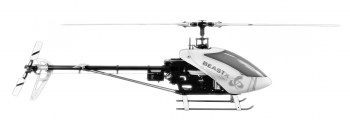Manuals:MBPlusFblV5:Setupmenu J/de: Difference between revisions
Shornstein (talk | contribs) No edit summary |
Shornstein (talk | contribs) No edit summary |
||
| Line 28: | Line 28: | ||
<br /> | <br /> | ||
= | =Einstellung am Gerät= | ||
Zu Beginn ist die Status LED aus, die Taumelscheibe steht waagrecht und die Rotorblätter sollten 0 Grad Pitchanstellwinkel haben. Befestige eine Pitcheinstelllehre am Blattgriff oder Rotorblatt und kalibriere diese auf 0.0 Grad. Tippe dann den Roll-Steuerknüppel einmal kurz an, dadurch fährt die Taumelscheibe in Messposition. Prüfe jetzt, ob die Pitchlehre +-6.0 Grad Pitch anzeigt und vergrößere/reduziere den Winkel, falls nötig, durch Antippen oder Halten des Heck-Steuerknüppels (links = reduzieren, rechts = vergrößern) solange bis 6.0 Grad anliegen (ob "+" oder "-" ist hierbei egal). Zwischen der Mess- und Neutralposition kann beliebig oft umgeschaltet werden. Wenn Du fertig bist, drücke kurz auf den Knopf, um zum nächsten Einstellpunkt zu wechseln.<br /> | |||
<br /> | <br /> | ||
<br /> | <br /> | ||
Revision as of 07:52, 3 June 2020
Unter diesem Einstellpunkt wird der zur Verfügung stehende zyklische Steuerweg eingelernt. Betätige vorerst noch keinen
Steuerknüppel. Richte stattdessen den Rotorkopf so aus, dass eines der Rotorblätter parallel zum Heckrohr/zur Längsachse
des Helikopters steht. Montiere dann eine Pitcheinstelllehre an diesem Rotorblatt.

|

|
Die Taumelscheibe muss neutral stehen und die Rotorblätter sollten 0° Pitchanstellwinkel haben. Falls das nicht der Fall ist, wiederhole die Einstellung der Servomitten unter Einstellpunkt H sowie die mechanische Einstellung.
Wechsle dann in die Messposition und prüfe den Pitchwinkel. Dieser muss genau 6.0 Grad betragen (das Vorzeichen bzw. die Richtung ist dabei unwichtig). Erhöhe oder reduziere den Pitchwinkel, falls notwendig. Wenn die 6° eingestellt wurden, sollte die Status LED blau leuchten. Das ist ein Zeichen, dass die Anlenkgeometrie des Helikopters optimal abgestimmt ist. Leuchtet die Status LED bei 6° hingegen in einer anderen Farbe oder überhaupt nicht so deutet das darauf hin, dass die Verhältnisse der Anlenkhebel am Helikopter nicht ideal sind und schon mit wenig Servoausschlag sehr große Anstellwinkel erreicht werden. Verwende in diesem Fall kürzere Servohebeln, andere Kugelbolzen an der Taumelscheibe oder längere Blatthalter-Anlenkhebeln. Andernfalls kann die ungünstige Geometrie dazu führen, dass der Regelkreis überreagiert. Schlechtes Einrastverhalten und übersensibles Flugverhalten können die Folge sein.
| Status-LED | Zyklischer Steuerweg |
| violett | zu wenig |
| rot | OK |
| blau | Perfekt! |
Einstellung am Gerät
Zu Beginn ist die Status LED aus, die Taumelscheibe steht waagrecht und die Rotorblätter sollten 0 Grad Pitchanstellwinkel haben. Befestige eine Pitcheinstelllehre am Blattgriff oder Rotorblatt und kalibriere diese auf 0.0 Grad. Tippe dann den Roll-Steuerknüppel einmal kurz an, dadurch fährt die Taumelscheibe in Messposition. Prüfe jetzt, ob die Pitchlehre +-6.0 Grad Pitch anzeigt und vergrößere/reduziere den Winkel, falls nötig, durch Antippen oder Halten des Heck-Steuerknüppels (links = reduzieren, rechts = vergrößern) solange bis 6.0 Grad anliegen (ob "+" oder "-" ist hierbei egal). Zwischen der Mess- und Neutralposition kann beliebig oft umgeschaltet werden. Wenn Du fertig bist, drücke kurz auf den Knopf, um zum nächsten Einstellpunkt zu wechseln.
Setup with StudioXm
Initially the swashplate will be leveled and rotorblades will have 0 degrees of pitch when the cyclic throw adjustment screen opens. Attach your pitch gauge at the rotorblade or blade grip, calibrate it to 0.0 degrees and then click the Measure button. This will move the rotorblade into measuring position. Now check the pitch gauge, we want to see exactly +-6.0 degrees. Increase/decrease the throw value with the + and - buttons or the dial until the pitch is adjusted correctly. You can switch back and forth between measure and zero position as often as you like.
Measuring pitch without pitch gauge
If your helicopter is too small for attaching a digital pitch gauge or simply in case you haven't got one you can use a little trick to measure the pitch anyway. You can calculate the angle from the distance the rotor blades move from zero position. Actually this is not so accurate as measuring with a pitch with a digital pitch gauge but it's better than nothing. All you need for this is a ruler and and exact eye. First you need to know the length of the rotorblades from the bolt hole to the outer edge. Usually this matches the specified rotor blade length of the manufacturer. Then you align the rotorhead with the longitudinal axis of the helicopter and fold both rotorblades to one side (as this will put heavy load on the servos it is not recommended use this method on large helicopters with heavy blades!). Now hold your ruler to the blades and mark the zero position. Then when you go into adjustment position the rotorblade will move up or down a few centimetres. This distance can be transfered into degrees of blade pitch using the mathematical formula of sinus. Or the other way round you can calculate how far you rotorblades must move in order to get 6.0 degrees of blade pitch.